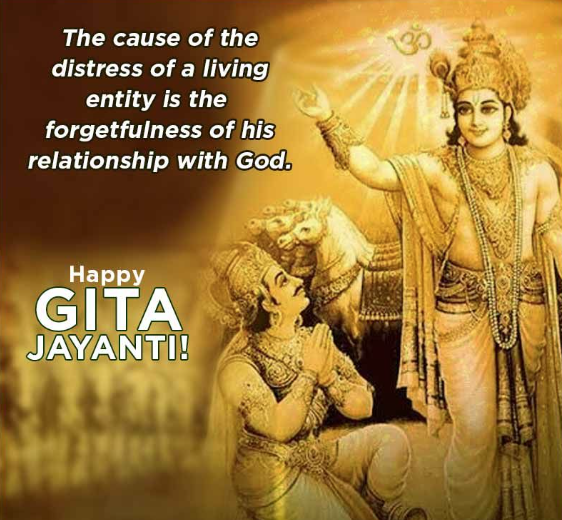the Bhagavad Gita, In a world marked by diversity and the search for inner peace. The 700-verse ancient Hindu scripture, stands as a timeless symbol of wisdom. Its profound teachings have crossed cultural and geographical boundaries to touch the hearts and minds of people around the world. The annual celebration of Gita Jayanti, which commemorates the day of the Gita’s revelation, provides an opportunity to embrace the universal messages of this sacred text. In this blog post, we will delve into the essence of the Bhagavad Gita and explore how its teachings remain relevant and transformative in our lives today.
Image sources Google
Table of Contents
Bhagavad Gita: A Timeless Spiritual Guide:
The Bhagavad Gita, also often spelled Gita, is a 700-verse Hindu scripture that is part of the Indian epic, the Mahabharata. It is presented as a conversation between Prince Arjuna and Lord Krishna, who serves as his charioteer and spiritual guide. The dialogue takes place on the battlefield of Kurukshetra, where Arjuna is full of doubts and moral dilemmas about fighting in the war.

Main topics and teachings:
Dharma (Duty): One of the central themes of the Bhagavad Gita is the concept of dharma. Arjuna is torn between his duty as a warrior and the moral dilemmas of killing his own relatives. Lord Krishna advises him about the importance of fulfilling his dharma, or duty, and the righteousness of performing his role as a warrior.
Self-realization: Geeta emphasizes the journey of self-discovery and attainment. Lord Krishna guides Arjuna to look within himself and understand his true nature, which is the eternal soul or spirit. This teaching encourages individuals to connect within themselves and find a deeper understanding of their existence.
Detachment: The Gita teaches the art of detachment, not in the sense of indifference but in the sense of performing one’s duties without attachment to the results. This concept helps individuals deal with success and failure with equanimity, reducing the impact of emotional turmoil.
Yoga: The Bhagavad Gita introduces various paths to spiritual attainment, including Bhakti Yoga (the path of devotion), Karma Yoga (the path of selfless action), Jnana Yoga (the path of knowledge), and Dhyana Yoga (the path of meditation) . , These paths offer diverse approaches to spiritual development, taking into account the different temperaments and inclinations of individuals.

Relevance in the modern world:
Despite being thousands of years old, the Bhagavad Gita offers profound insights and guidance for contemporary life. Let’s see how its teachings remain relevant in today’s world.
Stress Management: In a world plagued by stress and anxiety, Gita’s teachings on renunciation and equanimity can serve as powerful tools for stress management. By performing our duties with dedication but not being attached to the results, we can reduce the emotional turmoil that often accompanies success and failure.
Self-realization and mental health: The Gita’s emphasis on self-realization and understanding the nature of the self is closely linked to mental health and well-being. It encourages individuals to explore within themselves and find inner peace, which is important in a world plagued with mental health problems.
Ethical Dilemmas: Just as Arjuna faced ethical dilemmas on the battlefield, individuals today face ethical challenges in their personal and professional lives. The Gita’s teachings on religion and righteousness can provide guidance in making moral decisions.
Yoga and Spirituality: The popularity of yoga and meditation in the modern world is, in many ways, a testament to the influence of the Gita. The paths of yoga mentioned in the Gita, such as bhakti yoga and meditation yoga, are being practiced by millions of people around the world, helping people find spiritual peace.

Celebrating Geeta Jayanti:
Geeta Jayanti, the day that marks the birth of the Bhagavad Gita, is celebrated with great enthusiasm by Hindus and spiritual seekers across the world. It usually falls on Shukla Ekadashi of Margashirsha month in the Hindu calendar, which is usually in December. The day is celebrated with various rituals, discussions and recitation of verses from Gita.

How to Embrace the Universal Messages of the Bhagavad Gita:
While the Bhagavad Gita is deeply rooted in Hindu philosophy, its teachings can be adopted by individuals from all walks of life, regardless of their religious or cultural background. Here are some solid approaches to accomplishing this.
Read and Meditate: Start by reading the Bhagavad Gita and meditating on its verses. Many translations and commentaries are available making the text accessible to a wide audience. Take time to consider its teachings and how they relate to your life.
Practice Yoga and Meditation: Explore the different paths of yoga described in the Gita. Whether you’re drawn to the physical practice of Hatha Yoga, the devotional aspect of Bhakti Yoga, or the meditative journey of meditation
Curious to Know About Diwali! Please have a visit my Diwali post, Link is given bellow
Curious to Know About Navratri 2023! Please have a visit my Navratri post, Link is given bellow
Curious to Know About Celebrity? Please visit here

5 thoughts on “Gita Jayanti: Embracing the Universal Messages of the Bhagavad Gita!”